
No. 488 Squadron was the name given to two distinct Royal New Zealand Air Force squadrons during the Second World War. Both were formed under Article XV of the Empire Air Training Scheme and served under the operational command of the Royal Air Force.

No. 75 Squadron is a Royal Australian Air Force (RAAF) fighter unit based at RAAF Base Tindal in the Northern Territory. The squadron was formed in 1942 and saw extensive action in the South West Pacific theatre of World War II, operating P-40 Kittyhawks. It was disbanded in 1948, but reformed the following year and operated jet aircraft throughout the Cold War. The squadron was based at Malta from 1952 to 1954, flying de Havilland Vampires, and Malaysia from 1968 to 1983, with Dassault Mirage IIIs, before returning to Australia.
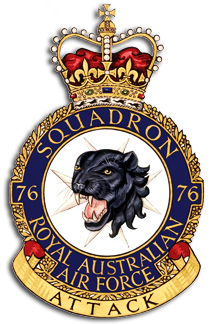
No. 76 Squadron is a Royal Australian Air Force (RAAF) flight training squadron. Established in 1942, it operated P-40 Kittyhawk fighter aircraft in the South West Pacific theatre during World War II. Following the end of hostilities it re-equipped with P-51 Mustangs and formed part of Australia's contribution to the occupation of Japan until disbanding in 1948. The squadron was re-formed in 1949 and three years later transferred to Malta, where it operated de Havilland Vampire jet fighters on garrison duty until again disbanding in 1955. It was reactivated in 1960 and operated CAC Sabre and Dassault Mirage III fighters in Australia until 1973. No. 76 Squadron was re-formed in its present incarnation in 1989 and is currently stationed at RAAF Base Williamtown, New South Wales, where it operates Hawk 127 jet training aircraft.

No. 452 Squadron is a Royal Australian Air Force (RAAF) air traffic control unit. It was established in 1941 as a fighter squadron, in accordance with Article XV of the Empire Air Training Scheme during World War II. The squadron flew Supermarine Spitfires for the entire war, initially over the United Kingdom and Nazi-occupied Europe. It was later based in Australia and the Netherlands East Indies, before being disbanded in 1945. It was re-raised in its current role in February 2011.
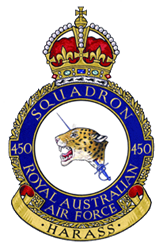
No. 450 Squadron was a unit of the Royal Australian Air Force (RAAF) that operated during World War II. Established at RAAF Station Williamtown, New South Wales, in February 1941, it was the first Australian Article XV squadron formed under the Empire Air Training Scheme.
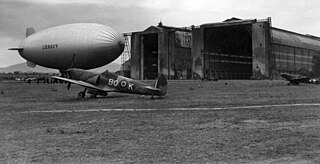
No. 451 Squadron was a Royal Australian Air Force army cooperation and fighter squadron of World War II. It was formed at Bankstown, New South Wales, on 12 February 1941 and began flying operations on 1 July as part of the North African Campaign in Egypt and Libya. No. 451 Squadron was withdrawn for refitting in early January 1942 and spent the remainder of the year performing garrison duties in Syria. In January 1943, it was transferred to Egypt to contribute to local air defence but saw almost no combat. This inactivity caused morale among the squadron's personnel to greatly deteriorate.
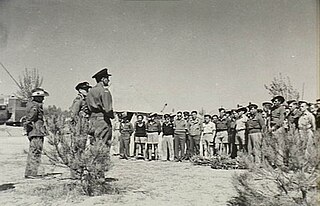
No. 454 Squadron was a unit of the Royal Australian Air Force (RAAF) that served during World War II. The squadron was raised in Australia under the Empire Air Training Scheme in mid-1941, but was disbanded shortly afterwards. It was re-formed later in 1941 from mainly British personnel and subsequently took part in the fighting in the Mediterranean and Middle East theatre before being disbanded in August 1945.

No. 78 Wing is a Royal Australian Air Force (RAAF) operational training wing, headquartered at RAAF Base Williamtown, New South Wales. It comprises Nos. 76 and 79 Squadrons, operating the BAE Hawk 127 lead-in fighter, and No. 278 Squadron, a technical training unit. No. 79 Squadron, located at RAAF Base Pearce, Western Australia, is responsible for converting new pilots to fast jets, while No. 76 Squadron at Williamtown conducts introductory fighter courses; both units also fly support missions for the Royal Australian Navy and the Australian Army.

No. 21 Squadron RAAF is a Royal Australian Air Force (RAAF) Airbase Operations squadron. Formed in the mid-1930s as a unit of the part-time Citizen Air Force (CAF), it was mobilised for service during World War II, when it saw action against the Japanese as a fighter unit in the Malayan campaign, a dive bomber unit in the New Guinea campaign, and a heavy bomber unit in the Borneo campaign. After the war, the squadron continued to fly until 1960, when the CAF ceased flying operations. At that time, No. 21 Squadron converted to a non-flying support role, which it currently fulfils at RAAF Base Point Cook and RAAF Williams - Laverton.

No. 461 Squadron was a Royal Australian Air Force maritime patrol squadron during World War II which operated under Royal Air Force control flying in Europe and over the Atlantic. The squadron was formed in 1942 and was disbanded in mid-1945, just after the end of the war in Europe. Personnel were drawn from many countries of the British Empire, although the majority were Australians. Throughout the war, the squadron was credited with destroying a total of six German U-boats, and operated mainly in the Bay of Biscay and Atlantic.
No. 462 Squadron is a Royal Australian Air Force (RAAF) squadron which forms part of the Information Warfare Directorate in the RAAF's Air Warfare Centre. The squadron was first formed in 1942 as a heavy bomber unit and saw combat in this role in the Mediterranean area until it was disbanded in March 1944. It was reformed in the United Kingdom in August 1944 to participate in the bombing campaign against Germany, and in December that year converted to a specialist electronic warfare unit. No. 462 Squadron continued in this role until the end of the European war in May 1945 and was disbanded in September that year. The squadron was reformed in its current role during April 2005.

No. 457 Squadron was a Royal Australian Air Force (RAAF) fighter squadron of World War II. Equipped with Supermarine Spitfire fighters, it was formed in England during June 1941 under Article XV of the Empire Air Training Scheme. The squadron was transferred to Australia in June 1942 and saw combat in the South West Pacific Area before being disbanded in November 1945.

No. 455 Squadron was a Royal Australian Air Force (RAAF) torpedo bomber squadron during World War II and became famous as part of the "ANZAC Strike Wing" that was formed from Australian and New Zealand squadrons. Raised in early 1941, mainly from Australian personnel, the squadron served over Europe during the war, operating from various bases in the United Kingdom; it also briefly sent a detachment to the Soviet Union in 1942. Operating Handley Page Hampdens and Bristol Beaufighters, the squadron mainly undertook anti-shipping and anti-submarine operations during the war. It was disbanded in May 1945 following the cessation of hostilities against Germany.

No. 456 Squadron RAAF was a Royal Australian Air Force (RAAF) night fighter squadron, operational over Europe during World War II. Formed in mid-1941, the squadron was the RAAF's only night fighter squadron. It was also the first RAAF unit to use a roundel featuring a red kangaroo in a blue circle, on some parts of its aircraft. While this insignia was unofficial and the squadron's main markings conformed to the RAF roundels used by British and other Commonwealth units, it inspired the post-war roundel used by the RAAF.
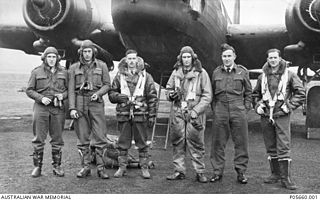
No. 458 Squadron RAAF was a Royal Australian Air Force squadron that operated during World War II. It was formed in Australia under Article XV of the Empire Air Training Scheme. The squadron flew various versions of Vickers Wellington bombers, first in Europe and later in the Middle East. It was disbanded in mid-1945, following the conclusion of hostilities in Europe.

No. 463 Squadron RAAF was a Royal Australian Air Force heavy bomber squadron during World War II. The squadron was formed in the United Kingdom in late 1943 from personnel and aircraft allocated from No. 467 Squadron RAAF. The squadron was equipped with Avro Lancaster bombers and flew its first raids on Germany immediately after being formed. Operating as part of RAF Bomber Command No. 463 Squadron conducted raids against cities, industrial facilities and military targets in Germany, France and Norway throughout 1944 and until the end of the war in May 1945. Following the war, the squadron evacuated Allied prisoners of war from Europe until it was disbanded in late 1945.

No. 464 Squadron RAAF is a Royal Australian Air Force (RAAF) unit responsible for public relations. It was originally formed in the United Kingdom during 1942 as a bomber unit. It comprised personnel from Australia, Britain, Canada, New Zealand, South Africa and the Netherlands, the squadron served in the light bomber role, undertaking operations over France and the Low Countries, from bases in England. It also flew night fighter missions. Later, following the Allied invasion of France, the squadron moved to France where it was used to interdict German transports and infrastructure. It further engaged in several low-level precision raids against Gestapo targets in France and Denmark. The squadron was disbanded in September 1945, following the conclusion of the war. No. 464 Squadron was re-formed in January 2021 when the RAAF's public relations functions were transferred from No. 28 Squadron.

No. 467 Squadron RAAF was a Royal Australian Air Force bomber squadron, active over North West Europe during World War II. Formed in November 1942 as an Article XV Squadron in Britain, the squadron was notionally an Australian squadron under the command of the Royal Air Force, and consisted of a mixture of personnel from various Commonwealth nations. After becoming operational in early 1943, the squadron flew operations in Occupied Europe until the end of the war flying Avro Lancaster heavy bombers. It was scheduled to deploy to the Far East to take part in further operations against Japan, but the war ended before it could complete its training and the squadron was disbanded in September 1945.
No. 548 Squadron RAF was a fighter squadron of the Royal Air Force (RAF) from 1943 to 1945.

No. 549 Squadron RAF was a fighter squadron of the Royal Air Force (RAF) operating in Australia from 1943 to 1945.





















